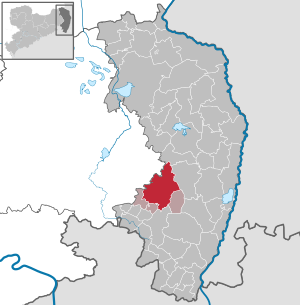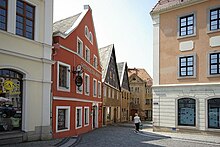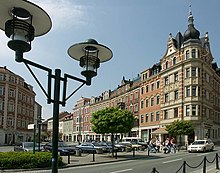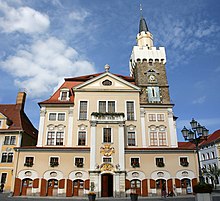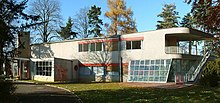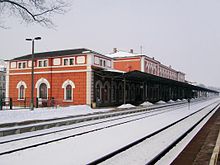Löbau
| coat of arms | Germany map | |
|---|---|---|
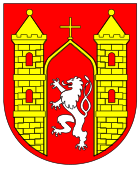
|
Coordinates: 51 ° 6 ′ N , 14 ° 40 ′ E |
|
| Basic data | ||
| State : | Saxony | |
| County : | Goerlitz | |
| Management Community : | Löbau | |
| Height : | 260 m above sea level NHN | |
| Area : | 78.9 km 2 | |
| Residents: | 14,456 (Dec. 31, 2019) | |
| Population density : | 183 inhabitants per km 2 | |
| Postal code : | 02708 | |
| Primaries : | 03585, 035876 (Mauschwitz) | |
| License plate : | GR, LÖB, NOL, NY, WSW, ZI | |
| Community key : | 14 6 26 290 | |
| LOCODE : | DE LBA | |
| City structure: | Core city and 24 districts | |
City administration address : |
Altmarkt 1 02708 Löbau |
|
| Website : | ||
| Lord Mayor : | Dietmar Buchholz ( independent ) | |
| Location of the city of Löbau in the district of Görlitz | ||
Löbau ( , Upper Sorbian ) is a large district town in the Görlitz district in Upper Lusatia in Saxony . It is part and also the administrative seat of the Löbau administrative community .
It is located about 75 km east of Dresden , 18 km south-east of Bautzen and 25 km south-west of Görlitz .
geography
Löbau is located on the eastern edge of the Lusatian mountainous region and the Lausitz region. The place is in the Löbauer Kessel, in the Saxon natural area of the Oberlausitzer Gefildes in the border area to the Oberlausitzer Bergland (northern main ridge). Small spatially adjoin: south the Kottmarmassiv , east of the Neisse hills and north of the Gefildezone with transition to Lausitz Plain. The cityscape is shaped by the eastern Löbauer Berg ( 447 m ) with Schafberg ( 449 m ) ("Löbau - Stadt am Berge"), the double summit has formed the 255 hectare landscape protection area (LSG) "Löbauer Berg" since 1974.
Geologically, there is a subsoil made of deep rock (granodiorite). The head of the source of the double mountain Löbauer Berg / Schafberg was created by volcanism in the Tertiary and consists of basalt rock . The basalt has weathered into blocks that cover large areas of the mountain in the form of rock heaps (block seas or "stone seas"). The lower parts of the Löbauer Kessel (240 to 270 m) have the shape of undulating loess plateaus , which consist of loess and alluvial clay, sand / gravel and granite.
Löbau is located at the confluence of the Seltenrein into the Löbauer Wasser , a tributary of the Spree .
Geotopes worth mentioning are the Georgewitzer Skala (a rocky valley cut of the Löbauer water north of the city) and the western hilltop of the Bubenik (also known as the Kleine Landeskrone - 376 m), whose basalt spring dome has been a natural monument since 1938 .
The town of Löbau also includes the mountain Kottmar (583 m), 10 km south , on whose western slope one of the three Spree springs is located.
Neighboring communities
Neighboring communities of Löbau are Vierkirchen in the north, the city of Reichenbach / OL in the northeast, Rosenbach in the southeast, Kottmar and Großschweidnitz in the south, Lawalde in the southwest and in the Bautzen district, the municipality of Hochkirch in the west and the city of Weißenberg in the northwest.
City structure
The city council of the large district town of Löbau decided in its session on July 7, 2011 a new structure of the city. The formerly independent villages Altlöbau (previously to Löbau), Dolgowitz (previously to Rosenhain), Oelsa (previously to Löbau), Unwürde (previously to Laucha), Wendisch-Cunnersdorf (previously to Rosenhain) and Wendisch-Paulsdorf (previously to Rosenhain ) declared as separate districts of the city of Löbau. The core urban area of Löbau was simultaneously divided into the districts of Löbau-Mitte, Löbau-Neustadt, Löbau-Nord, Löbau-Ost, Löbau-Süd and Löbau-West. The urban area now consists of 32 districts :
|
|
With the exception of the former settlements of Körbigsdorf , Liebesdörfel , Tiefendorf and Peschen (Stwěšin) , the subdivision of the urban area takes into account all formerly independent places.
history
Prehistory and early history
Finds of ceramic and bronze objects in the valley of the Löbauer water and a fortified hilltop settlement (ring wall or ski jump) on the Schafberg prove the prehistoric settlement of the area in the Bronze Age Lusatian culture (around 1000 BC). About 800 m southwest of the Löbau district of Bellwitz , the remains of the Slavic fortification Bielplatz Bellwitz from prehistoric times can be found on a rocky promontory above the Löbauer Wasser .
middle Ages
Löbau was first mentioned in 1221 as Lubaw by Bishop Bruno II of Meissen. The name comes from Sorbian , but the meaning is not certain. The city was planned around 1200 as part of the German East Settlement under Bohemian rule ( Ottokar I ) on a plateau above the marshy floodplain of the Löbauer Water. According to its original purpose, Löbau was planned as a trading and industrial site and was fortified with city walls. By 1319, the city was expanded to become a typical agricultural town . The local Franciscan monastery was first mentioned in 1336. Löbau belonged to the Upper Lusatian Six Cities Association , which was founded here in 1346. Because of its central location in Upper Lusatia, the city remained a federal convent until 1815. In 1359 a church building with the name capella Beatae Virginis extra muros (Church of the Holy Virgin outside the wall) was mentioned for the first time. It is unknown today whether the building existed before it was first mentioned in 1221.
Devastating fires repeatedly reduced parts of the city to rubble and ashes. A look at Badergasse shows what it once looked like in many streets - most of the houses faced the street with their gables.
Early modern age
Löbau was besieged and stormed several times during the Hussite Wars , which also ravaged Upper Lusatia from 1424 to 1434, in 1425 and 1428. In the last year, a Hussite-minded townspeople set fire to it in connection with this, with Löbau largely victim of the flames fell. In 1430 the Hussites again stood at the gates of the rebuilt city. This time the city surrendered to the Bohemians, was spared and occupied. The Bohemian-Hussite occupiers expanded the small town of six into the "main military base in the six lands". The Hussites more or less ruled Upper Lusatia at that time. The situation in Upper Lusatia was to change fundamentally after the Hussite defeat at the Battle of Lipany in 1434. Later wars, such as the Upper Lusatian Pönfall (1547) and the Thirty Years' War (1618 to 1648) as well as six city fires, hit Löbau hard. In 1678, half of the city was burned to ashes. The same happened on October 20, 1710. In the 17th century , the city was granted sovereign privileges, such as market and brewing rights and the ban mile. Around 1700 there was a heyday of linen weaving and extensive long-distance trade overseas. After the city fire of 1710, further urban development changes followed, e.g. B. the baroque building of the town hall (1711) and numerous town houses.
In the course of industrialization , Löbau was connected by Chausseen with Görlitz (1822), Bautzen (1824) and Zittau . In 1847 the connection to the Görlitz – Dresden railway followed . Further rail connections followed in 1848 to Zittau , 1873 to Ebersbach , 1895 to Weißenberg and 1928 to Cunewalde .
In the 19th century the textile industry dominated the small town. The first factory in Löbau was the red and colored dye works founded by Hildebrandt in 1835, from which the state-owned Upper Lusatian textile finishing plant was to emerge more than 100 years later. In addition, there were many other industries with a focus on processing such as For example: natural stone processing, brickworks, brewery, vinegar production, sugar factory, noodle production, cheese dairy, dairy and slaughterhouse, but also mechanical engineering, a grand piano and piano manufacture, rubber and carbon dioxide production. In 1898 a power station was opened and at the same time a gas station was operated. Löbau's location on the Dresden – Wroclaw long-distance railway had a positive effect on industrial development .
Until the early 20th century, in the villages west and north of the city - z. B. Großdehsa , Oelsa , Kittlitz - still the Löbauer dialect of Sorbian spoken; this is now extinct.
20th century
At the beginning of the 20th century, the city was the economic and cultural center of the Löbau administration with credit institutes, some offices such as the tax office, health department, garrison, police and district court with a prison. In 1912 a hospital was built.
In 1923 a newspaper printer was opened and in 1924 the “People's newspaper for Upper Lusatia” appeared. An artistic venue on Theaterplatz was planned, but was never built.
At the beginning of the 20th century there was a trade school, vocational school and trade school. There were teacher training centers in the city from 1873 to 1998 (1873–1935 Royal Teachers ' Seminar, 1955–1990 Institute for Teacher Training , 1993–1999 State Seminars for teaching at primary and secondary schools).
From 1914 to 1991 Löbau was a garrison town. Starting with a hunter barracks (1914) up to an officers' college for the land forces "Ernst Thälmann" (1963). During the First World War , Löbau was the location of a reserve hospital and was involved in war production. At the end of the Second World War , the city was not directly affected by acts of war, but almost all major road and rail bridges were blown up. In 1945 units of the Red Army moved in ; the Soviet occupation zone came into being.
post war period
In the period after 1945 the population and economy (especially the textile industry) grew; Löbau became a district town ( Löbau district ). In 1950 the “Stadium of Youth” was opened at the foot of the Löbauer mountain. After 1960 the city grew and expanded through new residential areas in the south (1955), north (1972) and east (1981). The development of the industrial and population center around Ebersbach and Neugersdorf in the south of the district also had an impact on Löbau.
In 1988 the city received another landmark: the 162 meter high concrete tower of the new television and radio station Löbau on the Schafberg was completed. In the 1970s and 1980s, the appearance of a textile industry and garrison town prevailed.
Löbau belonged to the so-called Valley of the Clueless : there could FM - Radio - and television broadcasts from the former territory of the Federal Republic of Germany (the GDR Western television called) with great effort not terrestrially received. The Löbauer therefore only received information from the censored GDR media .
After 1990
After the reunification of Germany in 1990, a profound structural change followed (decline of the majority of industrial companies, dissolution of the officers' college ), combined with a decline in the population and a loss of purchasing power. In the course of the district reform of 1994, Löbau lost its status as a district town (LÖB). In the newly formed district of Löbau-Zittau (ZI), which merged with the Saxon district reform in 2008 in the newly formed district of Görlitz, it achieved the status of a major district town in 2000, but lost almost all political and administrative functions to Zittau .
After successful inner-city redevelopment and inner-city design in the 1990s, the character of a small town predominates. Along with Kamenz and Niesky, Löbau is one of the smaller towns in Upper Lusatia with a city center that is well worth seeing and a scenic area that is attractive for tourists.
Incorporations
In 1934 Altlöbau was incorporated into Löbau. Oelsa followed in 1979, three municipalities in 1994, Ebersdorf in 1999 and Kittlitz in 2003.
In the years 1938, 1974 and 1994 a total of ten formerly independent towns were incorporated into Kittlitz.
| Former parish | date | annotation |
|---|---|---|
| Old Löbau | April 1, 1934 | |
| Bellwitz | March 22, 1970 | Merger with Georgewitz to form Georgewitz-Bellwitz |
| Carlsbrunn | April 1, 1974 | Incorporation to Kittlitz |
| Ebersdorf | January 1, 1999 | |
| Eiserode | January 1, 1994 | |
| Georgewitz | March 22, 1970 | Merger with Bellwitz to form Georgewitz-Bellwitz |
| Georgewitz-Bellwitz | March 1, 1994 | Incorporation to Kittlitz |
| Glosses | April 1, 1974 | Incorporation to Lautitz |
| Major dehsa | March 1, 1994 | |
| Kittlitz | January 1, 2003 | |
| Kleinradmeritz | March 1, 1994 | Incorporation to Kittlitz |
| Prong | April 1, 1974 | Incorporation to Kittlitz |
| Laucha | April 1, 1938 | Incorporation to Kittlitz |
| Lautitz | March 1, 1994 | Incorporation to Kittlitz |
| Oelsa | 1st January 1979 | |
| Opole | April 1, 1974 | Incorporation to Kittlitz |
| Rosenhain | March 1, 1994 | |
| Indignity | April 1, 1938 | Incorporation to Kittlitz |
| Wohla | April 1, 1974 | Incorporation to Kittlitz |
Population development
Population (until 2010 core city without districts, from 2011 entire city)
|
|
|
|
politics
City council
The city council of Löbau has a total of 22 members. You belong to the following parties or electoral associations:
| CDU | The left | Citizen List | FDP | SPD | AfD | total | |
| 1999 | 9 | 7th | 3 | 1 | 2 | - | 22nd |
| 2004 | 8th | 7th | 4th | 2 | 1 | - | 22nd |
| 2009 | 7th | 5 | 6th | 3 | 1 | - | 22nd |
| 2014 | 6th | 5 | 10 | 1 | 0 | - | 22nd |
| 2019 | 4th | 3 | 8th | 0 | - | 7th | 22nd |
|---|
Local councils
In each of the incorporated places there is a responsible local council with a local mayor . The main statute of the city of Löbau has introduced the local constitution for four localities. There is the locality Ebersdorf (district Ebersdorf), the locality Großdehsa (districts Eiserode, Großdehsa, Nechen and Peschen), the locality Kittlitz (districts Altcunnewitz, Bellwitz, Carlsbrunn, Georgewitz, Glossen, Kittlitz, Kleinradmeritz, Krappe, Laucha, Lautitz, Mauschwitz) , Neucunnewitz, Neukittlitz, Oppeln and Wohla) and the village of Rosenhain (districts Dolgowitz, Rosenhain, Wendisch-Cunnersdorf and Wendisch-Paulsdorf). The local councils are elected by the local population in each local election. You can be heard on important matters affecting the locality. The mayor is elected by the respective local council.
City leaders
At the head of the city stood the Consul regens, the ruling mayor. He was supported by the Exconsule, the 1st and 2nd deputy mayors. The government changed under these three mayors of the consulate.
Today's mayor is the mayor, since January 1, 2000 mayor , who is directly elected by the population for seven years. His permanent representative was the "First Alderman " with the official title of "Mayor", since 2016 he has been the Chief Executive Officer, followed by the Treasurer.
Mayor or (from 2000) Lord Mayor
- 1831–1832: Carl Heinrich Schluckwerder
- 1832–1842: Karl Benjamin Schöbel
- 1842–1850: Moritz Lieberecht Friedrich
- 1850–1883: Karl Hartmann
- 1883–1890: Ferdinant Paul Damm
- 1890–1912: Carl Ernst Otto Mücklich
- 1912–1922: Georg Wilhelm Schaarschmidt
- 1922–1945: Otto Willi Ungethüm ( NSDAP , arrested by Soviet forces, died in Bautzen)
- 1945: Johannes Bobeth (May 11-23 , deployed by the Soviet headquarters)
- 1945–1946: Otto Hermann (arrested by Soviet forces)
- 1946: Adolf Klinger (acting)
- 1946–1948: Gustav Meder ( SED )
- 1948–1950: Hermann Tütig
- 1950: Kurt Walter ( LDPD ) (September 1 - October 31, provisional)
- 1950: Walter Stöß (November 1 - December 10)
- 1950–1955: Kurt Walter (LDPD)
- 1955–1959: Gottfried Hahnewald
- 1959–1965: Hellmuth Walter (LDPD)
- 1965–1970: Oskar Zoubek
- 1970–1983: Hellmuth Schudack (LDPD)
- 1983–1989: Rainer Simmang (SED)
- 1989–1990: Isolde Thiele (SED, later non-party)
- 1990: Heinz Hartstein ( CDU , later SPD and non-party; was elected, but did not take office.)
- 1990–2001: Dietrich Schulte ( FDP )
- since 2001: Dietmar Buchholz (independent)
Associate or (2000–2016) mayor
- 1993–2001: Hans-Joachim Zimmermann (CDU)
- 2001–2016: Guido Storch (CDU)
As of January 9, 2016, there is no longer a mayor subordinate to the Lord Mayor due to a change in the main statute.
Administrative community
There is an administrative community with the neighboring communities of Lawalde , Großschweidnitz and Rosenbach , the fulfilling community of which is the town of Löbau.
Twin cities
-
 the Polish six-town Lauban (Lubań)
the Polish six-town Lauban (Lubań) -
 the large district town of Ettlingen in Baden-Württemberg
the large district town of Ettlingen in Baden-Württemberg
-
 City of Makó in Hungary
City of Makó in Hungary -
 the city of Épernay in France
the city of Épernay in France
Culture and sights
See: List of cultural monuments in Löbau
House make-up
The Schminke house in Kirschallee 1b is one of the most important works of classical modernism and an example of the so-called “ New Building ” as it was developed at the Breslau Art Academy and the Bauhaus . The Löbauer house was planned by Hans Scharoun for Fritz & Charlotte Schminke from 1930 to 1933 . It is considered to be Scharoun's main work in the field of private residential construction. It is therefore the destination of specialist excursions from all over the world and the subject of numerous publications. Overnight stays are possible for those interested in the subject. Universities and colleges can use the house for workshops and seminars.
The Schminke house joins the ranks of the most well-known modernists such as the Villa Tugendhat by Ludwig Mies van der Rohe , the Villa Savoye by Le Corbusier and the Kaufmann House ( Fallingwater ) by Frank Lloyd Wright .
The garden was designed by Herta Hammerbacher , the wife of landscape architect Hermann Mattern at the time . Both worked in partnership with the famous gardener and perennial grower Karl Foerster .
King Friedrich August Tower
Often referred to simply as the cast iron tower , it is a structural engineering monument on the Löbauer Berg . From the 28 meter high observation tower from 1854 there is a good all-round view. It has a cast-iron construction made up of around a thousand individual parts, mostly assembled using plug-in connections with lead fittings, and a total weight of around 70 t.
Its builder was the master baker Friedrich August Bretschneider , who financed the construction with approx. 25,000 thalers. The iron parts of the tower were cast in the ironworks in Bernsdorf / OL and have neo-Byzantine and neo-Gothic ornamentation. The octagonal tower has three galleries (12, 18 and 24 m high) that can be reached via a 120-step spiral staircase. A fundamental renovation with dismantling and reconstruction took place in 1993/94.
State Garden Show 2012
The 6th Saxon State Horticultural Show took place from April 28 to October 14, 2012 on the approximately 20 hectare former industrial site at Löbauer Wasser (Römer, Rabe, later LAUTEX and Oberlausitzer Zuckerfabrik or Südzucker ).
The industrial wasteland not far from the Friedenshain was redesigned into a park landscape that can also be used for recreation beyond the state horticultural show. In 2013 , the Bund Deutscher Landschaftsarchitekten awarded the first prize of the German Landscape Architecture Prize for the implementation .
Cultural center Johanniskirche
In the "Cultural Center of the Six Cities and the Euro region Neisse " in the St. John's Church , a former monastery church of the Franciscan from the 14th century, there are regular cultural activities index concert, theater, cabaret and cinema.
city Museum
The " Upper Lusatian Six- City Federation and Crafts Museum / City Museum Löbau" in Johannisstrasse offers permanent special exhibitions as well as a detailed permanent exhibition on the history of the Six-City Federation, the history of Upper Lusatian handicrafts and the history of the city of Löbau.
Other structures
- Baroque town hall (Altmarkt 1) from 1714 with moon phase clock , one of the last meat banks in Germany to be preserved within a town hall and the only historical council cellar still in operation within the six-city association (installed in 1935/36); built from 1710–1714 by Heinrich Prescher from Zittau from the remains of the previous building from the 15th century; 1825, 1842 and 1891 internal and external changes, 1990–1993 external restoration
- baroque town houses on the old market
- three formerly located in front of the city gates towards Bautzen, Görlitz and Zittau as replicas of the Kursächsische Postdistenzpäulen , whereby the coats of arms of the columns of the former Görlitzer and Zittauer Tor have been exchanged
- Nikolaikirche (1293) is the main church of the city (Evangelical Lutheran parish)
- The Church of the Name of the Virgin (1892) belongs to the Roman Catholic parish. A structurally identical sister church is located in Selzthal, Austria, in Styria.
- König-Albert-Bad , now a restaurant
- Brückner Villa (1901), Brücknerring
Catholic Church of the Name of the Virgin , consecrated in 1892
Memorials
- Graves and memorial stones on the southwest slope of the Jäckelberg for the eight war-weary Wehrmacht soldiers Hubert Dieteren, Erwin Fuhrig, Karl Koroschetz, Johann Kromp, Erich Radke, Rudolf Schmidt, Siegfried Wulf and an unknown person who were murdered in May 1945 after their hiding was betrayed
- Memorial plaque in the Geschwister-Scholl-Gymnasium for the communist Alfred Schmidt-Sas who was murdered on April 5, 1943 in the prison in Berlin-Plötzensee
- Sandstone stele from 1988 on the north wing of the district court at Promenadenring 3 in memory of the Jewish victims of the Löbau Shoah
- Memorial stone from 1960 opposite the house on Promenadenring 12 in memory of the KPD chairman Ernst Thälmann , who was murdered in the Buchenwald concentration camp in 1944
Sports
- FSV Empor Löbau , football club
- SV Horken Kittlitz, with the rugby, football, table tennis and volleyball departments
- SV Lautitz 96, football club
- ASG Vorwärts Löbau , former football club
- PSV (Police Sports Club) Löbau, Karate section
- KV Löbau, bowling club
- SV Lok Löbau, bike ball , senior sports , chess
- OSC Löbau, volleyball , athletics, running, Kempo
Economy and Infrastructure
traffic
The Löbau (Sachs) Station located near railroad tracks Görlitz-Dresden , Ebersbach-Löbau , Zittau Löbau , Großpostwitz-Löbau and Löbau-Radibor , one of which will last three no longer busy.
Löbau is on the federal roads 6 ( Dresden - Görlitz ) and 178 to Zittau . The closest connection point Weißenberg to the A4 is about 15 km north. Currently, the relocation and expansion of the B 178 from Löbau to Zittau and its extension to the federal motorway 4 near Weißenberg are under construction. So far, the Löbau bypass and most of the route to Zittau have been completed.
A cycle path leads from Löbau through the Cunewald valley to Großpostwitz , where there is a connection to the Spree cycle path .
Established businesses
In 1834 Johann Gottlob Hildebrandt built the first Löbauer factory, a red and colored yarn dyeing works. Until the fall of the Berlin Wall , the textile industry was one of the most important industries in Löbau, alongside the production of food. Löbau had a dairy, a sugar factory and a noodle factory, the Loeser & Richter company . But beer brewing also has a long tradition. The Bergquell brewery from 1846 still exists today. The Südzucker AG sugar factory was closed in autumn 2002.
In 1864 Reinhard Neumann founded the Löbauer tree and rose schools.
In 1896 J. Kumpf & Co. founded the company "Granitwerke und Steinbruchbetrieb", whose craft deals with the processing of natural stone. In 1947 the company was expropriated from the Soviet Union and transferred to state ownership. The owner was arrested along with his son. They were released after a show trial and went with their families to the West. In 1991 the company was re-established under the name "Löbau Granit GmbH". In 2010 the company was finally closed.
From 1918 to 1998 there was a railroad service vehicle plant in which goods and passenger cars of the Deutsche Reichsbahn were serviced.
As a traditional company in piano and piano manufacturing, August Förster has been based in Löbau since 1859. The Tischlerei Pötschke GmbH (since 1856), which looks back on 150 years of tradition and has been based on the Löbau industrial estate since 1996.
The Palfinger company has a factory for the production of aerial work platforms in Löbau.
The lighting company Hess GmbH had a branch in Löbau which also supplied the international market. The company received regular awards for its sophisticated design and high-quality workmanship. As a result of the insolvency of its predecessor "Hess AG", the plant closed on August 31, 2013.
The company Stempel Schmorrde has been based in Löbau since 1865. Initially as a book and newspaper printer, the company developed into one of the leading stamp and sign companies in Germany. In the company's own museum, the history of Gutenberg's printing press and machines related to this topic can be viewed.
Löbau is also the seat of the internationally renowned trance - music labels euphonic records .
Initially based in Reichenbach / Oberlausitz, the company ULT Umwelt-Lufttechnik, founded in 1994, moved into its headquarters in the Kittlitz industrial park in 2000. ULT AG develops and manufactures suction and filter devices and systems for industry, trade, research and medicine.
The EDB database company Hanel mbH looks after a large number of companies in the region with Internet marketing.
media
A local edition of the Sächsische Zeitung (SZ) published in Dresden appears as a daily newspaper in Löbau .
Public facilities
Löbau has, among other things, a local court , an office of the Employment Agency , a tax office , an office of the Federal Police (previously the Federal Border Police ), a branch office of the district office of the district of Görlitz, a rescue control center , an office of the state insurance company and a state audit office, as a subordinate office of the Saxon Court of Auditors .
education
The following schools are owned by the city in Löbau:
- two primary schools : "Am Löbauer Berg" primary school in Löbau-Ost and Kittlitz primary school
- a high school : Heinrich Pestalozzi High School
The district of Görlitz is responsible for the following in the Löbau urban area:
- two high schools : Geschwister-Scholl-Gymnasium and a business high school
- two vocational schools : the “August Förster” vocational school center and the vocational school center for business and technology
- a music school
- a community college
people
sons and daughters of the town
- Christian Trautmann (1678–1740), mayor, natural scientist and writer
- Gidion Görner (1748–1800), wholesaler and merchant, Societät Linen and Textile Trade with America
- Karl Benjamin Preusker (1786–1871), pioneer of the popular library movement
- Carl Wilhelm Traugott von Mayer (1796–1864), lawyer, manor owner and member of the Saxon state parliament
- Friedrich Oskar von Schwarze (1816–1886), lawyer and member of the Saxon Landtag and the Reichstag
- Karl August Mosig von Aehrenfeld ( Korla Awgust Mosak-Kłosopólski, 1820–1898), lawyer and member of the Reichstag, born in Eiserode
- August Förster (1829–1897), piano manufacturer
- Alfred Moschkau (1848–1912), publicist, poet and regional researcher
- Heinrich Curt Brückner (1851–1922), pharmacist, deputy mayor, royal Saxon councilor, honorary citizen of the city of Löbau
- Friedrich Wilhelm Kühlmorgen (1851–1932), lawyer and conservative politician, Member of the State Parliament (Kingdom of Saxony)
- Julius Sandt (1856–1928), entrepreneur, brewery director
- Theobald Hofmann (1861–1953), German architect, professor and specialist book author
- Marie Wackwitz (1865–1930), socialist politician, women's rights activist and journalist
- Willibalt Apelt (1877–1965), constitutional law teacher and politician (DDP), Saxon State Minister of the Interior 1927–1929
- Viktor Hermann Günther (1879–1965), Protestant clergyman
- Harry von Craushaar (1891–1970), lawyer, SS brigade leader and administrative officer
- Willi Auerswald (1894–1956), was part of the concentration camp staff of the Mauthausen concentration camp and the Steyr subcamp
- Georg Scholze (1897–1945), major general in World War II
- Heinrich Seeliger (1907–1995), retired German Brigadier General. D. and head of the Military Counterintelligence Service (MAD) from 1964 to 1967
- Rudolf Růžička (1920–2011), Slavist and linguist
- Konrad Kujau (1938–2000), painter and art forger, forger of Hitler's diaries
- Bernd Böhlich (* 1957), film director
- Uwe Proske (* 1961), Olympic champion in epee fencing (team)
- Peter Hinz (surgeon) (* 1964), surgeon
- Anne-Kathrin Schade (* 1968), national volleyball player
- Jörg Weißelberg (* 1968), guitarist and music producer
- Christiane Ernst-Zettl (* 1970), professional soldier
- Jana Henke (* 1973), swimmer
- Mirko Müller (* 1974), figure skater
- René Münnich (* 1977), racing car driver, racing team owner and entrepreneur
- Kyau & Albert , DJs and music producers
- Robert Koch (* 1986), soccer player
- Christian Reitz (* 1987), marksman
People who worked on site
- Andreas Kadner († 1659), organist, cantor and composer
- Christian Behrnauer (1649–1720), chief pastor
- Johann Gottfried Heinitz (1712–1790), teacher and hymn poet
- Carl Wilhelm August Weber (1871–1957), director of Löbauer Bank, member of the Reichstag
- Fritz Schminke (1897–1971), entrepreneur
- Herbert Fischer (1914–2006), diplomat of the GDR; was a teacher and school director in Löbau after the Second World War
Honorary citizen
- since September 4, 1860: Karl Benjamin Preusker (1786–1871), pioneer of public librarianship
- since September 30, 1860: Friedrich Oskar von Schwarze (1816–1886), lawyer, senior public prosecutor, attorney general in Dresden
- since 1861: Eduard von Könneritz (1802–1875), district director, councilor, board member of the Royal Saxon district directorate in Bautzen
- since April 16, 1871: Heinrich August Klose (1799–1884), cantor, senior teacher, knight pp.
- since 1872 ?: Paul Freiherr von Gutschmidt (1822–1904), district director in Bautzen
- since 1883: Heinrich Woldemar von Beust (1818–1898), district chief
- since September 25, 1886: Wilhelm Bernhard Würkert (1815–1888), Pastor Primarius, Council of Churches
- since 1895: Hermann Freiherr von Salza und Lichtenau (1829–1915), district chief of Bautzen
- since 1895 (resolution on February 22, 1895, presentation on May 8, 1895): Prince Otto von Bismarck (1815–1898), Reich Chancellor
- since 1906: Joachim Caspar Anton Richard von Schlieben (1848–1908), district chief von Bautzen, Saxon minister of education
- since June 27, 1909: Ernst Traugott Katzer (1839–1921), Pastor Primarius, Council of Churches
- since 1917: Paul von Hindenburg (1847–1934), officer, politician, president
- since December 29, 1921 (decision on December 20, 1921): Heinrich Curt Brückner , Hofrat, councilor from 1889–1921
- since 1936: M. Würkert, Primarius
- since May 24, 1944: Herbert Lorenz (1915–1994), sergeant major, first bearer of the Knight's Cross
- since April 30, 1948: Otto Staudinger (1867–1952)
- since March 24, 1950: Erich Viehweg (1880–1950), Ministerialrat, first Löbauer district school councilor after the end of the Second World War
- since June 22, 2001: Karl Keßner (1924–2014), flexographer , chief master of the stamp trade
- since January 12, 2012: Volker Stange, District Administrator a. D.
- since June 3, 2016: Steffen Dittmar, President of the Saxon Brewers' Association and Managing Director of Bergquell Brauerei Löbau GmbH
Honorary citizenships declared null and void:
- Decision of honorary citizenship on March 11, 1933: Adolf Hitler (1889–1945), decision to revoke it on October 5, 1990
- Decision of honorary citizenship on June 16, 1933: Martin Mutschmann (1879–1947), decision to dismiss on October 5, 1990
literature
- Sächsische Heimatblätter 3/2017 (themed booklet Löbau for the Day of Saxony 2017, with articles on geography, city, economic and cultural history).
- Karl Bernert : The cast iron tower on the Löbauer Berg. City Council, Löbau 1978.
- Between Löbau and Herrnhut (= values of the German homeland . Volume 56). 1st edition. Verlag Hermann Böhlaus successor, Weimar 1996, ISBN 3-7400-0935-7 .
- Rudolf Drescher: Löbau. Pictures of a city. Sutton, Erfurt 2003, ISBN 3-89702-606-6 .
- Peter Emrich, Rainer Lehmann: Löbauer city walks. Oberlausitzer Verlag, Spitzkunnersdorf 2005, ISBN 3-933827-56-6 .
- Peter Emrich: Löbauer city walks. Volume 2. Oberlausitzer Verlag, Spitzkunnersdorf 2006, ISBN 3-933827-64-7 .
- Peter Emrich: Löbauer country party. Worth seeing in the Löbauer Land. Oberlausitzer Verlag, Spitzkunnersdorf 2009, ISBN 978-3-933827-93-7 .
- Peter Emrich: Löbauer impressions. Photo brochure. Oberlausitzer Verlag Dr. Andreas Gerth, Spitzkunnersdorf 2017, ISBN 978-3-941908-98-7 (100 pages).
- Tino Fröde: privileges and statutes of the Upper Lusatian six cities. A journey through the organization of urban life in Zittau, Bautzen, Görlitz, Löbau, Kamenz and Lauban in the early modern period. Oberlausitzer Verlag, Spitzkunnersdorf 2008, ISBN 978-3-933827-88-3 .
- Cornelius Gurlitt : Löbau. In: Descriptive representation of the older architectural and art monuments of the Kingdom of Saxony. 34. Issue: Official Authority Löbau . CC Meinhold, Dresden 1910, p. 306.
- Alfred Moschkau : Löbau and its surroundings. A guide through this old four-city, to the Löbauer Berg, Cottmar, Rothstein, Sonneberg, Horken and into the Scala. Petzold, Dresden 1872 ( digitized version ).
- Hans-Henner Niese and Arnd Krenz: Urban redevelopment in Löbau 1992–2007. Edited by the advertising agency Media-Light Löbau in cooperation with the city administration Löbau u. v. a., Großschweidnitz 2007, without ISBN (brochure, 66 pages, A4 format).
- Werner Schmidt (Ed.): Between Löbau and Herrnhut. Results of the regional survey in the area of Löbau and Reichenbach / OL (= values of the German homeland . Volume 56). Böhlau, Weimar 1996, ISBN 3-7400-0935-7 .
- Siegfried Schlegel, Dieter Hans May: The Upper Lusatia. Excursions (= geographical building blocks. NR Volume 20). 4th, unchanged edition. Haack, Gotha 1989, ISBN 3-7301-0609-0 .
- City administration Löbau (ed.): Chronicle of the city of Löbau, 1221–1700. Published on the occasion of the 780th anniversary of the city of Löbau and the 655th anniversary of the six-city federation in 2001. Löbau 2001, ISBN 3-8311-2245-8 .
- FW Wenzlaff: Löbau in 1656. In: Preußische Provinzial-Blätter. Volume 23, Königsberg 1840, pp. 151-160 ( scan in Google book search).
Web links
- Internet presence of the city of Löbau
- Photo website - Löbau City and Country
- Memories of the old Löbau
- Löbau in the Digital Historical Directory of Saxony
Individual evidence
- ↑ Population of the Free State of Saxony by municipalities on December 31, 2019 ( help on this ).
- ↑ Research Association for Environmental Protection Zittau e. V. with the support of Mr. Lorenz and Mr. Küpper (text): The geological natural monuments of the district of Löbau-Zittau. 2nd Edition. Ed .: Nature conservation authority of the district of Löbau-Zittau in cooperation with the Research Association for Environmental Protection Zittau e. V. 2004 (leaflet; naturpark-zittauer-gebirge.de [PDF; 1.4 MB]).
- ^ Structure of the Löbau urban area ( Memento from January 6, 2014 in the Internet Archive ). In: loebau.de, accessed on December 19, 2019, with a link to the map of districts and districts overview of the city of Löbau ( Memento from January 6, 2014 in the Internet Archive ) (PDF; 2.6 MB). In: loebau.de, accessed on December 19, 2019.
- ↑ K. Simon: The Young Bronze Age settlement on the Schafberg near Löbau. In: Heinz-Joachim Vogt (Red.): Archaeological field research in Saxony. Fifty years of the State Museum for Prehistory Dresden (= work and research reports on the preservation of monuments in Saxony / supplement. No. 18). Deutscher Verlag der Wissenschaften, Berlin 1988, pp. 128-133.
- ↑ Information board at the old cemetery in Löbau. See: Alter Friedhof Loebau in Wikimedia Commons .
- ↑ entry. In: Johann Heinrich Zedler : Large complete universal lexicon of all sciences and arts . Volume 18, Leipzig 1738, sheet 88.
- ↑ a b c municipalities 1994 and their changes since January 1, 1948 in the new federal states. Ed .: Federal Statistical Office. Metzler-Poeschel publishing house, Stuttgart 1995, ISBN 3-8246-0321-7 .
- ↑ StBA: Changes in the municipalities in Germany, see 1999.
- ^ StBA: Changes in the municipalities in Germany, see 2003.
- ↑ Election results 2019. Community of Löbau, city. In: wahlen.sachsen.de, accessed on December 19, 2019.
- ↑ Landesgartenschau Löbau 2012 - official homepage. Retrieved December 19, 2019.
- ↑ Review 2013. In: Deutscher Landschaftsarchitektur-Preis. Retrieved February 28, 2017 .
- ↑ ULT AG Umwelt-Lufttechnik. Internet presence of ULT AG.
- ^ EDB database company Hanel mbH. Internet presence of the EDB database company Hanel mbH.
- ↑ Lusatian magazine or collection of various treatises and news on the grounds of natural, art, world and fatherland history, customs, and the beautiful sciences. Volume 10 to the year 1777. Fickelscherer, Görlitz 1778, p. 337 ( scan in the Google book search).
- ^ Karl Benjamin Preusker ( Memento from April 2, 2012 in the Internet Archive ). In: loebau.de, accessed on December 18, 2019.
- ^ Löbau, ev. Friedhof - resting place of the Curt Brückner family. In: loebaufoto.de, accessed on December 18, 2019 (photo of the tomb ).
- ↑ Löbau, Ev. Graveyard. This is where Prof. Otto Staudinger (1867–1952), teacher at the seminar and museum director, rests. In: loebaufoto.de, accessed on December 18, 2019 (photo of the tombstone).

